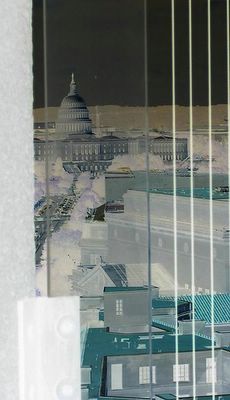CAPITOL SOUTH: Train Tunnel Would Complicate 'Pelosi House Office Building'

MATT YGLESIAS IS RIGHT: The surface parking lot to the south of the Cannon House Office Building and adjacent to the Capitol South Metrorail station escalators is pretty ugly, a space that could be used for more productive purposes. The ThinkProgress blogger wrote earlier this week that the space is perfect as "the future location of the Pelosi House Office Building."
But the construction of congressional office buildings has been a political hot potato for generations — for more background on the evolution of the congressional campus, see my article "The Keystone of Washington" from Roll Call's 50th Anniversary edition in 2005 and my piece about the construction of the Hart Senate Office Building from 2004.
For any future Pelosi House Office Building, the security challenges posted by First Street's train tunnel would complicate construction.
The tunnel that links Union Station's lower level train platforms — for Virginia Rail Express and Amtrak service serving points south of Washington — with L'Enfant Plaza and the Long Bridge over the Potomac River beyond curves directly under the parking lot where Yglesias would like to see an office building honoring the House speaker. You can see the tunnel portal here near New Jersey Avenue; at First and C streets SE, the tunnel curves north on its route to Union Station. Another Capitol Hill-area tunnel, under Virginia Avenue, sits nearby and provides a bypass of the First Street tunnel and Union Station for trains traveling between Virginia and Maryland.
Following the toxic Howard Street train tunnel fire in Baltimore in 2001 and general terrorism fears that unfolded in the years after the Sept. 11, 2001, attacks, the D.C. Council pushed legislation to ban hazardous shipments via rail within 2.2. miles of the U.S. Capitol.
As then-Ward 3 D.C. Council member Kathy Patterson wrote at the time:
Studies have shown that such an attack could create a deadly toxic cloud extending 14 miles, killing or injuring up to 100,000 people within 30 minutes and resulting in billions of dollars of economic damage. As noted by the District’s congressional representative, the Honorable Eleanor Holmes Norton, this is the “single greatest unaddressed security threat to the City. ... The Federal Government has not acted to prevent the terrorist threat resulting from the transportation of dangerous volumes of ultrahazardous materials through the Capitol Exclusion Zone.The Washington Post's Sally Quinn, explored the issue in 2006 in "Hell on Wheels":
If the railroads won't reroute hazardous shipments voluntarily, then what's the answer? It's simple: President Bush could pick up the phone and demand that they do so.Well, it was never that simple.
Rail operator CSX argued that the legislation interfered with interstate commerce and a legal challenge ensued in CSX Transportation v. The District of Columbia.
Washington, D.C., is a troublesome freight rail bottleneck on the East Coast and planners ideally see a freight rail bypass of downtown Washington, but that is a long way away. "It is unlikely that any of the bypasses would be operating before 2017 at the earliest," Greater Greater Washington's Matt Johnson wrote in in an examination of the topic last year.
While building atop of rail infrastructure isn't impossible — see Atlantic Terminal, the East Side Access Project and Penn Station/Moynihan Station/Hudson Yards redevelopment in New York City, or for that matter, the proposed Burnham Place development atop the Union Station rail yards in the District — it is expensive.
And security sensitive sites like Capitol Hill present additional challenges. So don't expect a Pelosi House Office Building anytime soon on top of that parking lot, no matter how ugly it is.
Photo of the Cannon House Office Building surface parking lot from Google Street View
Labels: capitol hill, capitol south, csx, d.c., train, tunnel, yglesias



0 Comments:
Post a Comment
<< Home